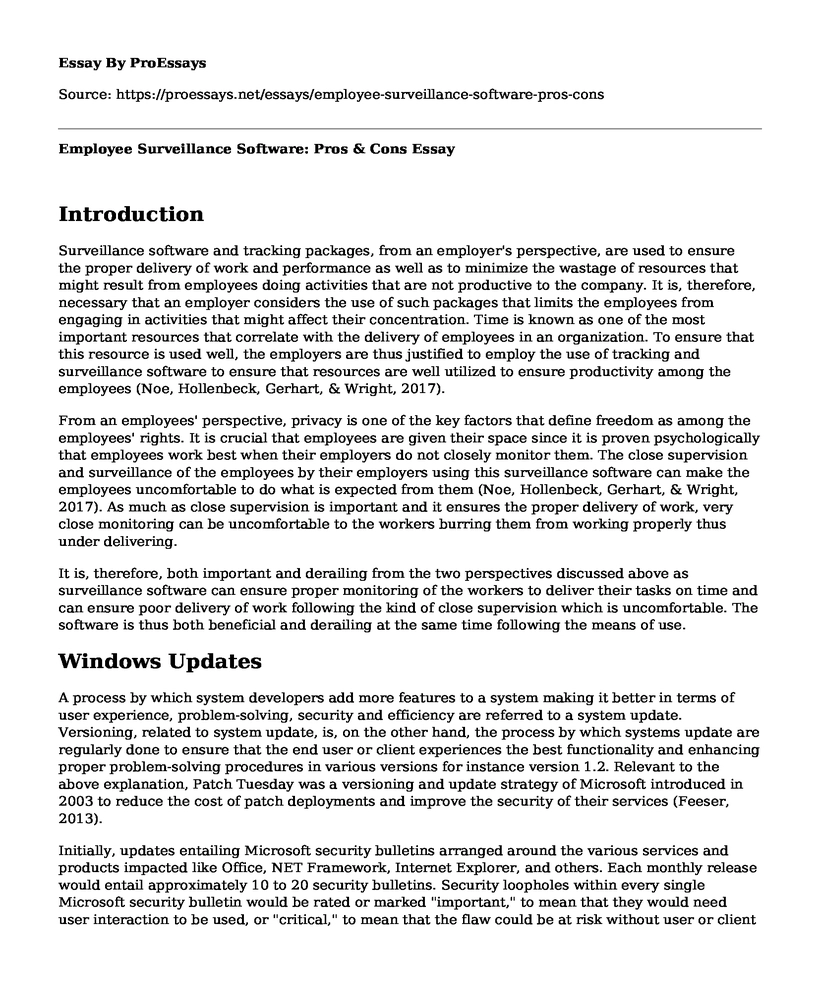Introduction
Surveillance software and tracking packages, from an employer's perspective, are used to ensure the proper delivery of work and performance as well as to minimize the wastage of resources that might result from employees doing activities that are not productive to the company. It is, therefore, necessary that an employer considers the use of such packages that limits the employees from engaging in activities that might affect their concentration. Time is known as one of the most important resources that correlate with the delivery of employees in an organization. To ensure that this resource is used well, the employers are thus justified to employ the use of tracking and surveillance software to ensure that resources are well utilized to ensure productivity among the employees (Noe, Hollenbeck, Gerhart, & Wright, 2017).
From an employees' perspective, privacy is one of the key factors that define freedom as among the employees' rights. It is crucial that employees are given their space since it is proven psychologically that employees work best when their employers do not closely monitor them. The close supervision and surveillance of the employees by their employers using this surveillance software can make the employees uncomfortable to do what is expected from them (Noe, Hollenbeck, Gerhart, & Wright, 2017). As much as close supervision is important and it ensures the proper delivery of work, very close monitoring can be uncomfortable to the workers burring them from working properly thus under delivering.
It is, therefore, both important and derailing from the two perspectives discussed above as surveillance software can ensure proper monitoring of the workers to deliver their tasks on time and can ensure poor delivery of work following the kind of close supervision which is uncomfortable. The software is thus both beneficial and derailing at the same time following the means of use.
Windows Updates
A process by which system developers add more features to a system making it better in terms of user experience, problem-solving, security and efficiency are referred to a system update. Versioning, related to system update, is, on the other hand, the process by which systems update are regularly done to ensure that the end user or client experiences the best functionality and enhancing proper problem-solving procedures in various versions for instance version 1.2. Relevant to the above explanation, Patch Tuesday was a versioning and update strategy of Microsoft introduced in 2003 to reduce the cost of patch deployments and improve the security of their services (Feeser, 2013).
Initially, updates entailing Microsoft security bulletins arranged around the various services and products impacted like Office, NET Framework, Internet Explorer, and others. Each monthly release would entail approximately 10 to 20 security bulletins. Security loopholes within every single Microsoft security bulletin would be rated or marked "important," to mean that they would need user interaction to be used, or "critical," to mean that the flaw could be at risk without user or client warning or interaction.
A security issue also could be marked "critical" if at all it was a zero-day, to mean that it was found being actively used in the wild environment before releasing the patch. It is therefore just to note that the parting process was important since it improved security capabilities and functionalities of the various Microsoft products. The above discussed is a brief explanation of how the patches are done ensuring the updates on the system. Windows 10, for instance, updates itself by prompting the user to schedule for the updates when he or she is not using the machine. This is done through notifications and reminders in case of any new development on the operating system.
References
Feeser, C. L. (2013). U.S. Patent No. 8,473,938. Washington, DC: U.S. Patent and Trademark Office.
Noe, R. A., Hollenbeck, J. R., Gerhart, B., & Wright, P. M. (2017). Human resource management: Gaining a competitive advantage. New York, NY: McGraw-Hill Education.
Cite this page
Employee Surveillance Software: Pros & Cons. (2022, Dec 30). Retrieved from https://proessays.net/essays/employee-surveillance-software-pros-cons
If you are the original author of this essay and no longer wish to have it published on the ProEssays website, please click below to request its removal:
- Google Leadership
- Business Administration and Organizational Behavior Paper Example
- Workplace Stress Paper Example
- Essay Example on High-Performance Team Leadership in Nursing Environment
- Essay Example on Leadership: Indra Nooyi's Role in PepsiCo's Success
- Shareholder vs. Stakeholder Theory: A Corporate Governance Debate - Essay Sample
- Essay Example on Corporate Social Responsibility: Enhancing Brand Value & Improving Society







